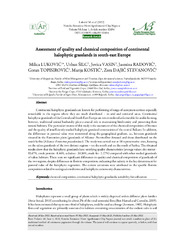Приказ основних података о документу
Assessment of quality and chemical composition of continental halophytic grasslands in south-east Europe
| dc.creator | Luković, Milica | |
| dc.creator | Šilc, Urban | |
| dc.creator | Vasin, Jovica | |
| dc.creator | Radović, Jasmina | |
| dc.creator | Topisirović, Goran | |
| dc.creator | Kostić, Marija | |
| dc.creator | Dajić Stevanović, Zora | |
| dc.date.accessioned | 2022-05-12T09:47:16Z | |
| dc.date.available | 2022-05-12T09:47:16Z | |
| dc.date.issued | 2022 | |
| dc.identifier.issn | 0255-965X | |
| dc.identifier.issn | 1842-4309 | |
| dc.identifier.uri | http://fiver.ifvcns.rs/handle/123456789/2654 | |
| dc.description.abstract | Continental halophytic grasslands are known for performing of range of ecosystem services especially remarkable in the regions where they are much distributed – in arid and semi-arid areas. Continental halophytic grasslands of the Central and South-East Europe are not considered as favourable for arable farming, however, traditional animal husbandry plays a crucial role in maintaining biodiversity and preserving these natural habitats. The particular interest of this study is the assessment of the chemical composition of biomass and the quality of insufficiently studied halophytic grassland communities of the central Balkans. In addition, the differences in pastoral value were monitored along the geographical gradient, i.e., between grasslands situated in the Pannonian plain (grasslands of Alliance Puccinellion limosae) and those distributed on the south Serbia (Alliance Festucion pseudovinae). The study was carried out at 18 representative sites, focusing on the saline grasslands of the two distinct regions – on the north and on the south of Serbia. The obtained results show that the halophytic grasslands have satisfying quality characteristics (average values: dry matter - 93.67%, crude protein - 8.66%, cellulose - 30.36%, crude fat - 2.27%) compared with other studied grasslands of saline habitats. There were no significant differences in quality and chemical composition of grasslands of the two regions, despite differences in floristic composition, indicating that salinity is the key determinant for pastoral value of the halophytic vegetation. The certain variations were attributed to the specific floristic composition related to ecological conditions and halophytic community characteristics. | sr |
| dc.language.iso | en | sr |
| dc.publisher | Cluj-Napoca : AcademicPres | sr |
| dc.relation | info:eu-repo/grantAgreement/MESTD/inst-2020/200116/RS// | sr |
| dc.relation | Slovenian Research Agency, research core funding P-0236 | sr |
| dc.rights | openAccess | sr |
| dc.rights.uri | https://creativecommons.org/licenses/by/4.0/ | |
| dc.source | Notulae Botanicae Horti Agrobotanici Cluj-Napoca | sr |
| dc.subject | chemical composition | sr |
| dc.subject | continental halophytic grasslands | sr |
| dc.subject | suitability for utilization | sr |
| dc.subject | halophytic grasslands | sr |
| dc.subject | grasslands | sr |
| dc.subject | quality | sr |
| dc.subject | south-east Europe | sr |
| dc.subject | ecosystems | sr |
| dc.subject | biomass | sr |
| dc.subject | Balkans | sr |
| dc.subject | Serbia | sr |
| dc.subject | salinity | sr |
| dc.subject | pastoral value | sr |
| dc.subject | floristic composition | sr |
| dc.title | Assessment of quality and chemical composition of continental halophytic grasslands in south-east Europe | sr |
| dc.type | article | sr |
| dc.rights.license | BY | sr |
| dc.citation.issue | 1 | |
| dc.citation.rank | M22 | |
| dc.citation.spage | 12694 | |
| dc.citation.volume | 50 | |
| dc.identifier.doi | 10.15835/nbha50112694 | |
| dc.identifier.fulltext | http://fiver.ifvcns.rs/bitstream/id/7334/notulae.pdf | |
| dc.identifier.scopus | 2-s2.0-85128857654 | |
| dc.identifier.wos | 000779788900008 | |
| dc.type.version | publishedVersion | sr |


